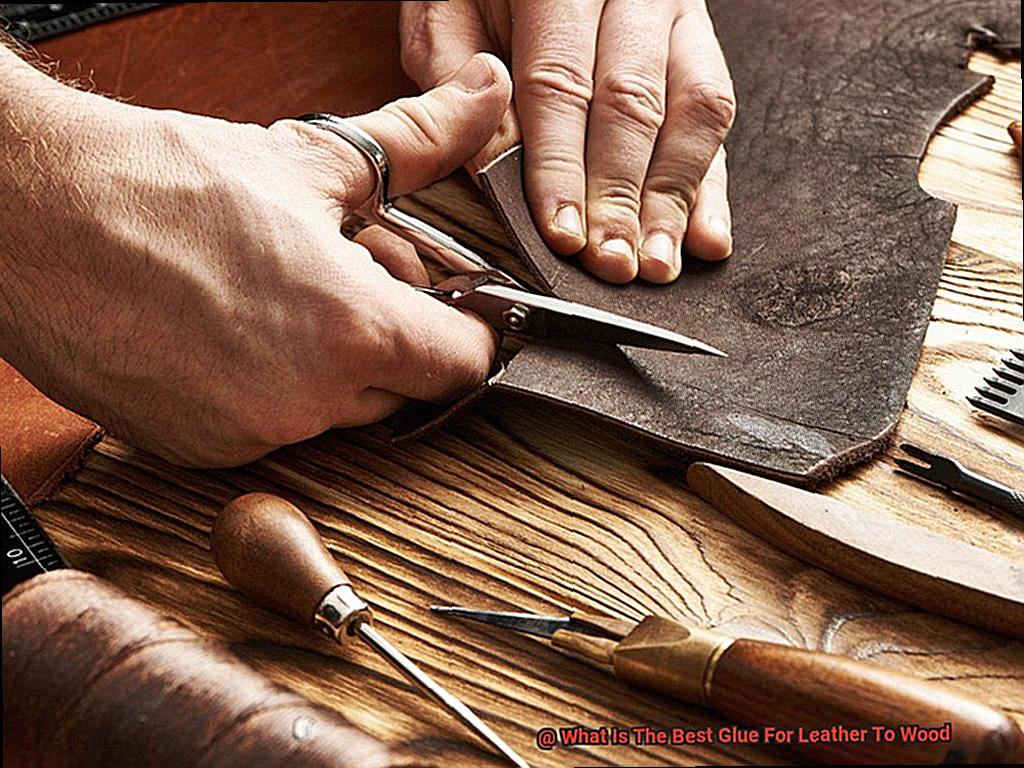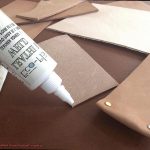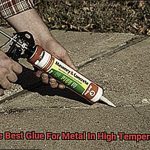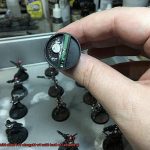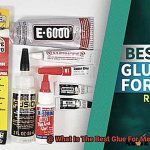Are you a DIY enthusiast or a seasoned craftsman, ready to embark on an exciting journey into the captivating realms of leatherwork and woodworking? From crafting one-of-a-kind furniture pieces to hand-stitching leather accessories, the possibilities are truly endless. But there’s one challenge that stands in your way – finding the perfect glue for leather to wood.
Choosing the right adhesive is paramount in ensuring a bond that can withstand the test of time, enduring wear and tear. Whether you’re repairing a cherished leather chair or assembling intricate wooden frames for your leather artwork, the glue you select plays a pivotal role in determining your project’s success.
Join us as we dive headfirst into the fascinating world of adhesives, unveiling which glue reigns supreme when it comes to bonding leather to wood. We’ll explore essential factors to consider, discuss popular options, and provide invaluable insights from our experts. Together, we’ll help you unleash your craftsmanship and bring your creative visions to life.
So grab your trusty tools, don your DIY hat, and prepare yourself for an adventure as we unlock the secrets of finding the best glue for leather to wood.
What is Glue?
Contents
Glue, a seemingly simple substance, possesses the remarkable ability to create strong and durable bonds between different materials. When it comes to bonding leather to wood, choosing the right adhesive is crucial for a successful and long-lasting connection. In this article, we will explore the world of glue, its various types, and the best options for achieving a secure bond between leather and wood.
Types of Glue:
- Contact Cement: This versatile adhesive forms an instant bond when two surfaces are pressed together. It is commonly used in woodworking and can be applied to both leather and wood. However, it may not be suitable for applications that require the removal or replacement of the leather.
- Epoxy Adhesive: Known for its exceptional strength and durability, epoxy consists of two components that are mixed together before application. It creates a chemical reaction that results in a powerful bond. Epoxy is ideal for heavy-duty applications and can withstand extreme conditions.
- Hide Glue: Derived from animal collagen, hide glue has stood the test of time as a reliable adhesive in woodworking. It provides a strong bond that can withstand tension and shear forces. One advantage of hide glue is its ability to be softened with heat and water, allowing for easy disassembly if needed.
- Polyurethane Glue: This versatile adhesive bonds different materials and expands as it cures, filling any gaps or irregularities between the leather and wood surfaces. Polyurethane glue offers excellent moisture resistance and can be used both indoors and outdoors.

Choosing the Right Glue:
When selecting an adhesive, consider factors such as the type of leather, type of wood, and intended use. It is essential to test the glue on a small, inconspicuous area before proceeding with the full application to ensure compatibility and desired results.
Types of Glue for Leather to Wood
When it comes to crafting or repairing projects involving leather and wood, selecting the right glue is essential for achieving a strong and long-lasting bond. With a plethora of options available, it can be overwhelming to determine which adhesive is best suited for your particular project. In this article, we will explore several types of glue that can be used to adhere leather to wood, enabling you to make an informed decision.
Contact Cement: The Instant Grip
Contact cement is a go-to choice for bonding leather to wood due to its robust adhesive properties. This rubber-based glue creates an instantaneous bond when both surfaces are coated and pressed together. Its easy application and durability make it ideal for withstanding heavy stress. Simply ensure an even coat on both the leather and wood surfaces, allow it to dry until tacky, and firmly press them together.
Epoxy: Strength and Durability
For a strong and durable bond, epoxy adhesive is the go-to option. Composed of two components – resin and hardener – it initiates a chemical reaction that results in a powerful bond. Epoxy is resistant to heat, water, and chemicals, making it suitable for heavy-duty applications. However, precise mixing and application are necessary as it can be messy and challenging to clean once dry.
Polyurethane Adhesive: Versatility at Its Best
Polyurethane adhesive, also known as PU glue, is a versatile option that works well for bonding leather to wood. It forms a robust bond capable of withstanding heat, water, and chemicals. One distinguishing feature is its ability to expand during the curing process, filling gaps and providing additional strength to the bond. Nonetheless, excess glue may foam up during curing, so wipe away any surplus before it dries.
Cyanoacrylate (Super Glue): Quick and Convenient
For small projects or quick repairs, cyanoacrylate, commonly known as super glue, is a fast-drying adhesive that forms a strong bond between leather and wood. It provides an instant grip, making it ideal for immediate use. However, super glue may not be the best choice for larger surfaces or applications requiring flexibility, as it can become brittle over time.
Hot Glue: Crafting Delights
Hot glue, also referred to as hot melt adhesive, is a popular choice for crafts and DIY projects involving leather and wood. It provides a strong bond and dries quickly, making it convenient for immediate use. However, it may not be the best option for high-stress applications or long-term durability.
Contact Cement
Look no further than the incredible adhesive known as contact cement. In this blog post, we will delve into the world of contact cement and discover how it can be your secret weapon for achieving strong and durable bonds between these two materials. So grab your glue and let’s uncover the magic of contact cement.
The Mighty Strength of Contact Cement:
Contact cement stands tall as the go-to adhesive for bonding leather to wood, thanks to its unrivaled strength and durability. This versatile adhesive forms an instant grip, creating a bond that can withstand even the most challenging conditions.
Preparation: The Key to Success:
Before diving into the application process, it is crucial to prepare both the leather and wood surfaces properly. Begin by meticulously cleaning them, eliminating any trace of dirt or oils that could hinder adhesion. Next, gently sand both surfaces to create a rough texture that ensures maximum grip for the adhesive.
Mastering Application Techniques:
When it comes to applying contact cement, you have options aplenty. Whether you prefer a brush or a roller, make sure to spread the adhesive evenly on both surfaces. Remember, complete adhesion requires complete coverage, so don’t skimp on the glue.
Patience Rewarded:
After applying contact cement, it’s crucial to exercise patience. Allow the adhesive to dry completely according to the manufacturer’s instructions. Rushing this step could compromise the bond, so resist the temptation to hurry things along.
The Perfect Fusion:
Now comes the moment of truth – bringing leather and wood together in holy matrimony. Align the two surfaces properly and press them firmly together, applying even pressure across the entire area for a strong and uniform bond.
Testing for Perfection:
While contact cement is generally suitable for bonding leather to wood, it’s always wise to perform a small-scale test before committing to the full application. This will help identify potential issues, such as finishes or coatings that may interfere with adhesion.
Conclusion:
Contact cement is a reliable and versatile adhesive for bonding leather to wood. Its exceptional strength, resistance to heat and moisture, and ability to bond different materials make it an ideal choice for a wide range of projects. By following proper surface preparation techniques, applying the adhesive evenly, and allowing sufficient drying time, you can create long-lasting and visually stunning leather-to-wood masterpieces.
Epoxy Adhesive
In the adhesive world, one product reigns supreme when it comes to bonding leather to wood – epoxy adhesive. This mighty bond offers a plethora of advantages, making it the top choice for professionals and DIY enthusiasts alike. Let’s delve into the fascinating world of epoxy adhesive and discover why it is the ultimate solution for achieving a strong and durable bond between leather and wood.
Exceptional Strength:
When it comes to bonding materials under heavy loads and stress, look no further than epoxy adhesive. It boasts an unmatched ability to withstand constant pulling or tension, making it perfect for applications like furniture upholstery or leather-wrapped handles on wooden tools and instruments. With epoxy adhesive, rest assured that your bonded leather and wood will hold up even in the toughest conditions.
Resistance to Environmental Factors:
Epoxy adhesive is a true champion in resisting temperature changes, moisture, and chemicals. Bid farewell to worries about your beautiful leather-wood creations being affected by rain or extreme temperatures. Whether it’s outdoor furniture or leather-covered outdoor structures, epoxy adhesive ensures that your bonded leather items stay securely in place, no matter the environmental conditions they encounter.
Proper Surface Preparation:
To achieve the best results with epoxy adhesive, proper surface preparation is crucial. Ensure that both the leather and wood surfaces are clean, dry, and free from any dirt, dust, or grease. For enhanced adhesion between the materials, lightly roughen the surfaces with sandpaper. This simple step will make a world of difference in the strength of your bond.
Application Technique:
Applying epoxy adhesive is a breeze. Spread a thin and even layer on both the leather and wood surfaces using a brush or spatula. Once applied, press the two surfaces firmly together, ensuring even contact. To keep everything in place while the adhesive cures, use clamps or weights. Remember, patience is key during the curing process – avoid any stress or movement that could compromise the bond.
Hide Glue
In this article, we will explore the advantages of using hide glue, its unique properties, and why it continues to be a favorite among craftsmen and artisans.
Reversibility:
Hide glue stands out from synthetic glues because of its reversibility. Unlike other adhesives, hide glue can be softened with heat or moisture. This allows for easy disassembly or repairs without causing damage to the materials being bonded. So when you’re working on a project where preserving the integrity of wood or leather is paramount, hide glue is your best friend.
Compatibility with Different Materials:
Hide glue forms a strong bond with both wood and leather, providing a reliable and long-lasting connection. Its natural properties allow it to penetrate porous surfaces, ensuring a secure bond that can withstand stress and strain. Whether you’re restoring furniture or creating leather accessories, hide glue is your trusty companion.
Aesthetics and Ease of Use:
When properly applied, hide glue dries clear and leaves no visible residue or marks. This makes it perfect for applications where the glue line needs to be inconspicuous. Whether you’re crafting furniture or fashioning leather goods, hide glue ensures a seamless finish that highlights the beauty of your creations.
Versatile Forms:
Hide glue comes in various forms, including granules, liquid, and ready-to-use formulations. The granules require mixing with water and heating before application, while the liquid and ready-to-use options eliminate additional preparation steps. The choice of form depends on personal preference and project requirements.
Shelf Life Considerations:
It’s important to note that hide glue has a limited shelf life compared to synthetic adhesives. Once mixed, it should be used within a specific timeframe to ensure optimal performance. However, unopened packages of hide glue, when stored properly in a cool and dry place, can have a relatively long shelf life.
Polyurethane Glue
Polyurethane glue, also known as PU glue, is a versatile adhesive that is essential for anyone working on projects involving bonding leather to wood. This remarkable glue offers a multitude of benefits that make it the go-to choice for craftsmen and hobbyists alike.
The key advantage of polyurethane glue lies in its ability to adhere to a wide range of surfaces. Leather and wood are vastly different materials, with leather being porous and wood being non-porous. However, polyurethane glue has the remarkable ability to bond these materials seamlessly, creating a strong and durable connection.
Strength and durability are two characteristics in which polyurethane glue excels. It can withstand high levels of stress, making it perfect for applications where the bonded surfaces may be subjected to frequent use or harsh conditions. Moreover, this glue exhibits excellent resistance to temperature changes, moisture, and chemicals, ensuring that your leather-wood bond will stand the test of time.
When using polyurethane glue for leather to wood bonding, there are a few considerations to keep in mind. First and foremost, it is crucial to ensure that both surfaces are clean and free from any dirt, dust, or grease. This will optimize the adhesive strength and enhance the overall bond. Secondly, applying the glue evenly and in the appropriate amount is essential for achieving optimal results.
One notable characteristic of polyurethane glue is its expansion as it cures. Although this expansion fills gaps and provides additional strength to the bond, it can also result in excess glue oozing out from the bonded area. To avoid this, clamps or other means of applying pressure on the surfaces being bonded should be utilized.
Other Considerations When Selecting the Best Glue for Leather to Wood
When it comes to bonding leather to wood, selecting the right glue is crucial for a strong and long-lasting bond. While polyurethane glue is often the go-to choice, there are several other considerations that should be kept in mind to ensure the success of your project. In this guide, we will explore these factors and provide you with expert advice on selecting the best adhesive for your specific needs.
Consider the type of wood and leather:
Different types of wood and leather have varying porosity and texture, which can affect how well the glue adheres. Smooth and non-porous wood surfaces may require a stronger adhesive, while rough or porous surfaces may need a glue that can penetrate effectively.
Evaluate the leather’s characteristics:
Genuine leather typically has a more porous surface compared to synthetic leather or suede. Choose a glue that can seep into the pores of the leather and create a secure bond.
Flexibility and stretchability:
Leather is known for its natural flexibility and ability to stretch. Select a glue that can maintain this flexibility without compromising the bond, preventing cracks or breakage when the leather is flexed or stretched.
Consider the intended use and conditions:
For outdoor furniture or items exposed to moisture, choose a waterproof or water-resistant glue to prevent bond deterioration. Evaluate other environmental factors such as temperature changes or exposure to chemicals.
Additional features:
Quick-drying glues can be advantageous for time-sensitive projects. Be aware of any strong odors or toxic fumes emitted by certain glues, as they may be unsuitable for indoor use or projects involving frequent skin contact.
Follow manufacturer’s instructions:
Always read and follow the instructions provided by the glue manufacturer. This includes guidelines on application techniques, drying times, and any necessary precautions.
u_sZe9IRA4k” >
Also Read: Best Glue for Twigs and Branches – Glue Things
Conclusion
In conclusion, there are several standout contenders for the title of best glue for leather to wood. One top choice is contact cement, known for its strong and instantaneous bond that can handle heavy stress applications with ease. If strength and durability are your priorities, epoxy adhesive is a fantastic option. It not only withstands heat, moisture, and chemicals but also provides exceptional long-lasting hold.
For those who value reversibility and compatibility, hide glue is the way to go. Its unique properties allow for easy disassembly if needed and make it compatible with various materials. And let’s not forget about polyurethane glue, which offers versatility like no other. It bonds different surfaces effortlessly and expands as it cures, filling gaps and providing that extra bit of strength.
When choosing the right glue for your project, don’t forget to consider factors such as the type of leather and wood you’re working with, the intended use of your creation, flexibility requirements, and environmental conditions. Properly preparing the surfaces by thoroughly cleaning them and creating a rough texture will ensure maximum adhesion.
Always remember to follow the manufacturer’s instructions when it comes to application techniques and drying times. Performing a small-scale test beforehand will give you peace of mind regarding compatibility and desired results.

